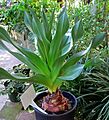White squill
| White squill | ||||||||||||
|---|---|---|---|---|---|---|---|---|---|---|---|---|

White sea onion ( Drimia maritima ), |
||||||||||||
| Systematics | ||||||||||||
|
||||||||||||
| Scientific name | ||||||||||||
| Drimia maritima | ||||||||||||
| ( L. ) Stearn |
The white sea onion ( Drimia maritima (L.) Stearn ), also called sea onion for short (from Middle High German merzwibolle ), is a species of plant native to the Mediterranean region that belongs to the asparagus family (Asparagaceae).
Botanical synonyms are Charybdis maritima (L.) Speta , Urginea maritima (L.) Baker , Urginea scilla Steinh. , Basionym : Scilla maritima L.
features
The white sea onion is a perennial herbaceous plant and reaches stature heights of about 50 centimeters without blooming, including the inflorescence up to 150 centimeters. Their only basal leaves are broadly lanceolate, up to 50 centimeters long, survive the winter months and wither in early summer, i.e. H. the plant "moves in". It survives the summer dry season as a resting geophyte with the help of a strikingly powerful onion, which gave rise to the name of the whole plant. The onion can reach a diameter of more than 15 centimeters, weighs up to 3 kilograms and often protrudes from the ground. Depending on the breed, it can be white or red in color.
In autumn (August to October), before the leaves sprout, the florid, racemose inflorescence appears up to 40 centimeters long. The six bracts are up to 8 millimeters long, whitish, with a purple or green central nerve.
Occurrence
The white sea onion is widespread throughout the Mediterranean and Tenerife. It mostly prefers near the coast , pastures and garigues , also grows on sandy soils and rocky corridors. It is avoided by grazing cattle. Cultures were established in the USA, India and Pakistan.
ingredients
The most important pharmacologically active substances are around 12 different cardiac glycosides from the bufadienolide group with a total content of 0.2 to 0.4%, especially scillaries A (0.06%), proscillaridin A (0.05%) and glucoscillaries A. (0.05%); the content varies depending on the origin. The red onion contains mostly scilliroside , while the white onion contains mainly scillaries A. The content of flavonoids and anthocyanins should also be noted.
Medical importance
The German Pharmacopoeia (DAB) lists sea onions (Scillae bulbus) as a medicinal drug . The drug consists of medium-sized, fleshy onion scales cut across and lengthways, which come from plants collected after the flowering period. The white onion breed is used. The DAB requires a bufadienolide content of 0.15 to 4.0%; Medically important representatives are Scillaren A and Proscillaridin A. The drug itself is hardly used nowadays; instead, pure proscillaridin is used. The indication area are mild forms of heart failure ( cardiac strength-increasing effect).
pharmacology
Pharmacokinetics
The white sea onion, usually short sea onion (Latin "scilla"), works similarly to the glycosides from foxglove ( digitalis ), but is faster and less effective than this. In addition, the effect of accumulation (accumulation with repeated use) occurs to a lesser extent than with digitalis . The oral bioavailability is 25%.
toxicology
The sea onion is to be regarded as highly poisonous, so the active ingredients must be precisely dosed. The entire plant is poisonous, especially the bulb. Amounts between 0.1 and 1.5 g of sea onion administered orally (by mouth) have already led to deaths in children. Possible symptoms of intoxication (poisoning) include cardialgia (heart pain), dysuria , hematuria and disorders in the digestive tract . Death can occur from cardiac paralysis and the associated cardiac arrest . Inhaled particles cause an urge to sneeze . Externally, plant parts cut into small pieces can lead to blistering and dermatitis . Therapy is symptomatic.
history
The use of the sea onion as a medicinal plant dates back to ancient times. Theophrast and Pliny recommended it because of its diuretic effect, Dioscurides used it for dropsy and asthma and Albertus Magnus saw in it a regulating effect. In the 18th century, the direct effect on the heart was discovered. It was also used as a rat poison ( rodenticide ). The sea onion was used fresh or dried and as an extract , tincture and acetum , with its diuretic effect being the main focus until the 20th century.
photos
Inflorescence on the island of Djerba , Tunisia
literature
- Karl Hiller / Matthias F. Melzig (ed.): Lexicon of medicinal plants and drugs. Spectrum Akademischer Verlag GmbH, Heidelberg / Berlin 2003 = Directmedia Publishing GmbH, Berlin 2005, ISBN 3-89853-544-4 (digital library 144).
- Renate Germer: Handbook of the ancient Egyptian medicinal plants. (Philippica 21). Harrassowitz, Wiesbaden 2008.
Individual evidence
- ^ Drimia maritima in the Germplasm Resources Information Network (GRIN), USDA , ARS , National Genetic Resources Program. National Germplasm Resources Laboratory, Beltsville, Maryland.
- ↑ a b c Stahl & Schild: Pharmaceutical Biology 4; Drug Analysis II: Ingredients and Isolations , Gustav Fischer Verlag, Stuttgart / New York, 1981, ISBN 3-437-20209-X .
- ↑ a b c Roth, Daunderer & Kormann: Poison Plants - Plant Poisons, 5th Edition, NIKOL Verlag, 2008, ISBN 3-86820-009-6 .
- ↑ a b c de Gruyter: Pschyrembel; Clinical Dictionary. 261st edition, 2007, Walter de Gruyter, Berlin, New York, ISBN 978-3-11-018534-8 .
- ↑ a b c Bettina Rahfeld: Microscopic Color Atlas of Plant Drugs , Spectrum Academic Publishing House, 2009. ISBN 978-3-8274-1951-4 .
- ↑ man Fried Pahlow: The Big Book of Medicinal Plants , Bechtermünz Publishing (licensed edition of Weltbild Verlag GmbH, Augsburg 2000), ISBN 3-8289-1839-5 .
- ↑ Jerry Stannard: Squill in ancient and medieval materia medica: With special reference to its employment for dropsy. In: Bulletin of the New York Academy of Medicine , New Series, 50, 1974, pp. 684-713.
- ^ Pistoia: Le piante della salute , Arnoldo Mondadori Editore, SpA, Milano.
- ^ Wolf-Dieter Müller-Jahncke , Christoph Friedrich , Ulrich Meyer: Medicinal history . 2., revised. and exp. Ed. Wiss. Verl.-Ges, Stuttgart 2005, ISBN 978-3-8047-2113-5 , pp. 72 .



